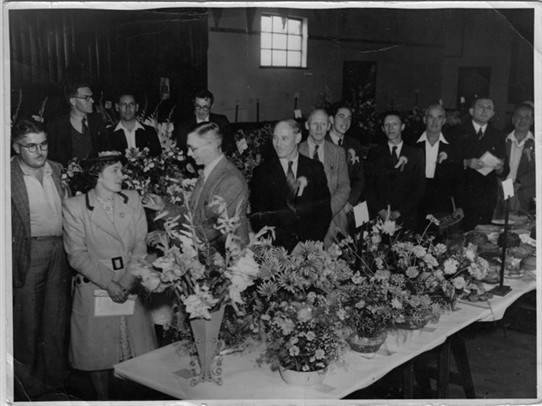St. Helier Horticultural Society
Allotments, vegetables and winning that prize
By Phillip Newell
St Helier Horticultural Society Gardens and allotments are an everyday feature to present residents of the estate but to the very first residents it was the opposite. Most of them had never experienced the luxury of a garden, having come from inner city areas. Gardening was completely new to them and would be very much a learning curve. Another obstacle to developing a garden was, to many, an Anderson air-raid shelter taking up most of the backgarden. The answer was an allotment, if you could get one, My parents came from a deprived area of Islington and likewise had no experience of gardening. Langdon Walk had a small back-garden and Dad managed to obtain an allotment and joined the St Helier Horticultural Society.
The front garden at 1, Langdon Walk.
Donated by Phillip Newell
His allotment was on a corner site where Middleton Rd joined St Helier Ave. It became a regular sight to see allotment holders walking up St Helier Avenue, evening and weekends, pushing their homemade wheelbarrows or carrying their tools. Sunday was usually the busy day, as most people worked a five and a half day week. Whilst the acquisition of an allotment was principally to supplement the shortage of fresh fruit and vegetables, due to rationing and the aftermath of the war, it served other purposes. The allotment became a social meeting place where allotment holders could discuss not only gardening but create long term friendships. Many holders were very competitive and aimed to have the best allotment producing the best produce. The St Helier Horticultural Society was the ideal place to meet other gardeners and further their knowledge. I must have been about 10 years of age when I used to go, with my father, up to the ‘hut’ on a Sunday morning, where the other members would come to purchase their fertilizer and seed. This was where I first heard about ‘dried blood’ and ‘bone meal’. These, and many others, were very much in short supply. Again, this was a great place for gardeners to socialize and gossip. I must add, the first time I became involved, in what one would describe as an allotment, was when I was about 9 years of age at Lilleshall Road, Junior School, where we had a wonderful headmaster called Mr White. Along the edge of the playground was a strip of land about 8ft wide which he decided to convert to an allotment, so with the aid of the pupils he went ahead. This was great fun for us keen youngsters, but a bit difficult digging with a gasmask in a box hanging around your neck. We grew potatoes, brassica’s and root vegetable’s, some of which we were able to purchase. To be able to take home fresh vegetables in the middle of the war was almost unheard of. A blessing for our mothers!
Flower judging 1945 George Newell 2nd left.
Donated by Phillip Newell
For members of the Horticultural Society the great event of the year was the Annual Show which, if my memory is correct, was held in the Community Hall in Middleton Rd. All members, and their family members, were awaiting the day when they could demonstrate their skills to other members and the general public. As, with shows today, there were classes for the ladies, children and the men. Each section was judged independently. One judge I remember very clearly was Mr Moore. He was always there, whatever show, to judge the allotment produce. I was only a youngster throughout this period but I have the feeling that he may have been the Head Gardener on the Hatfeild’s Estate. He lived in the cottage facing Morden Hall Rd next to the drive leading up to the old mill. He had wonderful plums etc. growing up the old wall of the kitchen garden with the stream running past the cottage and under the wall. The plot which ran from the stream to the main road was an immaculately laid out allotment. A truly professional garden.
St. Helier Horticultural Society 1945 George Newell (Secretary of the Society) on the right
Donated by Phillip Newell
I remember how those people exhibiting flowers, particularly the large snowball chrysanthemums, would spend ages, before judging, adjusting the petals with tweezers looking for earwigs. On the day of the show an empty hall was transformed from a frantic madhouse, with everyone dashing around to ensure that everything was in it’s correct place,into a fantastic display of colour. What a display of the most beautiful flowers and the finest vegetables you could ever expect to see. All these produced by members who, in a very short period of time, had become very accomplished gardeners. We should not forget the ladies. Homemade jam, wonderful cakes and preserving jars full of fruit. I can see my mother, now, carefully arranging the fruit in the jars, ready for the Show. Remember, the fruit used by exhibitors was usually unattainable in the shops, but came from their allotment. Judging time! Great excitement as judging was completed and exhibitors were allowed back in to see how they had competed, looking for that ‘First’ award. At the end of the judging the judges declared the winner in each class. Then everyone held their breath to hear who was declared the show champion. One for the men and one for the ladies. To my mothers acute embarrassment she won the award the first time she entered. Net result, she never entered again! I still carry the medal she won.

Prizegiving at the Horticultural Society. George Newell at the front wearing a blazer.
Donated by Phillip Newell
Mrs Newell's winners medal. Reverse says St. H.H.S. H.L. Newell 1949
Donated by Phillip Newell